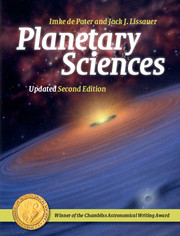Book contents
- Frontmatter
- Contents
- List of Tables
- Preface
- 1 Introduction
- 2 Dynamics
- 3 Solar Heating and Energy Transport
- 4 Planetary Atmospheres
- 5 Planetary Surfaces
- 6 Planetary Interiors
- 7 Magnetic Fields and Plasmas
- 8 Meteorites
- 9 Minor Planets
- 10 Comets
- 11 Planetary Rings
- 12 Extrasolar Planets
- 13 Planet Formation
- Appendix A List of Symbols Used
- Appendix B Acronyms Used
- Appendix C Units and Constants
- Appendix D Periodic Table of Elements
- Appendix E Observing Techniques
- Appendix F Interplanetary Spacecraft
- Appendix G Recent Developments in Planetary Sciences
- References
- Index
- Plate Section
Preface
Published online by Cambridge University Press: 05 January 2015
- Frontmatter
- Contents
- List of Tables
- Preface
- 1 Introduction
- 2 Dynamics
- 3 Solar Heating and Energy Transport
- 4 Planetary Atmospheres
- 5 Planetary Surfaces
- 6 Planetary Interiors
- 7 Magnetic Fields and Plasmas
- 8 Meteorites
- 9 Minor Planets
- 10 Comets
- 11 Planetary Rings
- 12 Extrasolar Planets
- 13 Planet Formation
- Appendix A List of Symbols Used
- Appendix B Acronyms Used
- Appendix C Units and Constants
- Appendix D Periodic Table of Elements
- Appendix E Observing Techniques
- Appendix F Interplanetary Spacecraft
- Appendix G Recent Developments in Planetary Sciences
- References
- Index
- Plate Section
Summary
Preface to the First Edition
The study of Solar System objects was the dominant branch of Astronomy from antiquity until the nineteenth century. Analysis of planetary motion by Isaac Newton and others helped reveal the workings of the Universe. While the first astronomical uses of the telescope were primarily to study planetary bodies, improvements in telescope and detector technology in the nineteenth and early twentieth centuries brought the greatest advances in stellar and galactic astrophysics. Our understanding of the Earth and its relationship to the other planets advanced greatly during this period. The advent of the Space Age, with lunar missions and interplanetary probes, has revolutionized our understanding of our Solar System over the past forty years. Dozens of planets in orbit about stars other than our Sun have been discovered since 1995; these massive extrasolar planets have orbits quite different from the giant planets in our Solar System, and their discovery is fueling research into the process of planetary formation.
Planetary Science is now a major interdisciplinary field, combining aspects of Astronomy/Astrophysics with Geology/Geophysics, Meteorology/Atmospheric Sciences, and Space Science/Plasma Physics. We are aware of more than ten thousand small bodies in orbit about the Sun and the giant planets. Many objects have been studied as individual worlds rather than merely as points of light. We now realize that the Solar System contains a more dynamic and rapidly evolving group of objects than previously imagined. The cratering record on dozens of imaged bodies shows that impacts have been quite important in the evolution of the Solar System, especially during the epoch of planetary formation. Other evidence, including the compositions of meteorites and asteroids and the high bulk density of the planet Mercury, suggests that even more energetic collisions have disrupted objects. More modest impacts, such as the collision of comet D/Shoemaker–Levy 9 with Jupiter in 1994, continue to occur in the current era. Dynamical investigations have destroyed the regular ‘clockwork’ image of the Solar System that had held prominence since the time of Newton.
- Type
- Chapter
- Information
- Planetary Sciences , pp. xiv - xviPublisher: Cambridge University PressPrint publication year: 2015



